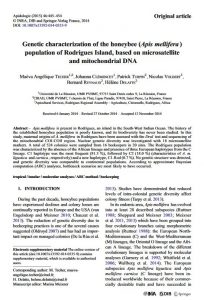Apis mellifera is present in Rodrigues, an island in the South-West Indian Ocean. The history of the established honeybee population is poorly known, and its biodiversity has never been studied. In this study, maternal origins of A. mellifera in Rodrigues have been assessed with the DraI test and sequencing of the mitochondrial COI-COII region. Nuclear genetic diversity was investigated with 18 microsatellite markers. A total of 524 colonies were sampled from 16 beekeepers in 20 sites. The Rodrigues population was characterised by the absence of the African lineage and presence of three European haplotypes from the C lineage. C1 haplotype was the most frequent (81.3 %), followed by C2 (18.0 %) (characteristics of A. m. ligustica and carnica, respectively) and a new haplotype, C1-Rod (0.7 %). No genetic structure was detected, and genetic diversity was comparable to continental populations. According to approximate Bayesian computation (ABC) analyses, bottleneck scenarios are most likely to have occurred.
Region: Mauritius
Date published:
2014
Published by:
Apidologie
Type of resource:
Journal article
Resource topic:
Honeybee
Project/Programme: Not specific
Pest/Disease: Not specific
Pages:
10
File type:
External link (502 KB)




